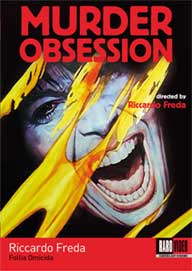 MURDER
OBSESSION (1981)
MURDER
OBSESSION (1981)Director: Riccardo Freda
Raro Video USA
 MURDER
OBSESSION (1981)
MURDER
OBSESSION (1981)You really can’t (or shouldn’t) go home again, as Riccardo Freda shows in his gory final feature MURDER OBSESSION, finally out on DVD from Raro Video USA.
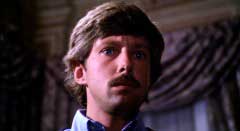
When actor Michael Stamford (Stefano Patrizi, CONVERSATION PIECE) nearly kills his leading lady Beryl (Laura Gemser, BLACK EMANUELLE) in his latest horror film, he is overcome with a compulsion to return to his family home where he murdered his father (also Patrizi) when he was a child. He comes home to a creaky old villa where his mother Glenda (Anita Strindberg, THE TEMPTER) lives alone with manservant Oliver (John Richardson, BLACK SUNDAY). Michael introduces his girlfriend Deborah (Silvia Dionisio, LIVE LIKE A COP DIE LIE A MAN) to his mother as his secretary (which is just as well, because his cougar-ish mother is very touchy-feely with her baby boy). Deborah is less than pleased to be introduced as a secretary, and to be given a room near the attic, but Michael’s got his own demons to deal with. The next day, Michael’s director Hans (Henri Garcin, THE PINK PANTHER) arrives to discuss a new project with him, bringing along Beryl and assistant director Shirley (Martine Brochard, EYEBALL). After dinner, discussion of voodoo and the occult leads to a sleepless night. Hans goes for a walk in the woods and runs into a sleepwalking Oliver, Deborah dreams that she participates in a Black Mass in the villa’s dungeons, and someone tries to drown Beryl in her bath (I know, I know… you’re thinking it’s likely Oliver, but why is Hans wearing black gloves with his sleepwear?). The next day, Michael, Hans, Beryl and Shirley leave Deborah behind and take a drive out into the woods to look at filming locations. When Beryl brings up Michael’s composer father, Michael confesses to falling into trances and not remembering what he has done (which apparently happened to him when he killed his father). Michael and Beryl split off together and make love by the lake. He wakes up later to discover that Beryl has been gutted with his own hunting knife. Michael hiding the body suggests that he may be guilty of murder – he certainly seems to think so – but does his continued absence explain the axe and chainsaw-wielding presence that has started to stalk the rest of the cast back at the villa? Deborah gets to find out on a conveniently dark and stormy night with knocked-out electricity and missing vehicles.
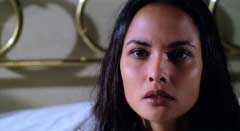 Riccardo
Freda’s last film curiously finds him in similar territories as Mario
Bava with his own final feature SHOCK/BEYOND THE DOOR II, which put a supernatural
twist on incestuous overtones; however, Freda’s use of miniatures, in-camera
opticals and stop-start camera trickery is less accomplished (the villa exterior
shots are the same establishing shot photograph with fake flora that is not
out-of-focus enough to be convincing, the wavy distortion in front of the lens
sometimes looks more like lens flare and there are no eyes in the grayish prosthetic
head that figures into the film’s gory axe-to-the-head bit). It would
be tempting to suggest that Freda was appealing to 1980s slasher sensibilities
with the graphic gore; however, his earlier 1970s gothic horror pic TRAGIC CEREMONY
AT VILLA ALEXANDER featured some Carlo Rambaldi graphic gore (including a head
split in half by a red hot sword) and the various acid scarrings and throat
slashings of his giallo IGUANA WITH THE TONGUE OF FIRE. Some of Cristiano Pogany’s
(LAST HOUSE ON THE BEACH) camerawork – particularly those focusing on
Michael’s visits to his mother’s bedside – recalls imagery
from Freda’s THE HORRIBLE DR. HICHCOCK and Bava’s LISA AND THE DEVIL;
however, the perversion here is incest rather than necrophilia, so they evoke
an aura of queasiness rather than one of the macabre (Pogany was the son of
cinematographer Gabor Pogany, who shot seven films for Freda, including the
Italian/German Edgar Wallace thriller DOUBLE FACE and THE SINS OF ROME; oddly,
they both died in 1999). A handful of suspense-worthy events are recalled in
flashback (Hans’ encounter with a sleepwalking Hans, and Deborah’s
nightmare) when they might have been better rendered in the story’s present
as part of the group’s first eventful night in the villa. What isn’t
ridiculously overstated in the dialogue – such as Hans’ attachment
to his camera – is over-emphasized by Pogany’s emphatic zooms and
Franco Mannino’s – or someone else’s (more on that later)
– music stingers. The supernatural and giallo aspects do not really mesh
well – a tired after-dinner discussion of voodoo and other occult practices
serves to cast suspicion on no one in particular – what with invisible
beings tracking muddy footprints into rooms where visible black-gloved assailants
strike (not to mention a hilarious giant spider out of Luigi Batzella’s
NUDE FOR SATAN), but it does result in a memorable closing shot that beautifully,
or blasphemously, mimics the Pietà lamentation of Christ (particularly
Michelangelo’s sculpture).
Riccardo
Freda’s last film curiously finds him in similar territories as Mario
Bava with his own final feature SHOCK/BEYOND THE DOOR II, which put a supernatural
twist on incestuous overtones; however, Freda’s use of miniatures, in-camera
opticals and stop-start camera trickery is less accomplished (the villa exterior
shots are the same establishing shot photograph with fake flora that is not
out-of-focus enough to be convincing, the wavy distortion in front of the lens
sometimes looks more like lens flare and there are no eyes in the grayish prosthetic
head that figures into the film’s gory axe-to-the-head bit). It would
be tempting to suggest that Freda was appealing to 1980s slasher sensibilities
with the graphic gore; however, his earlier 1970s gothic horror pic TRAGIC CEREMONY
AT VILLA ALEXANDER featured some Carlo Rambaldi graphic gore (including a head
split in half by a red hot sword) and the various acid scarrings and throat
slashings of his giallo IGUANA WITH THE TONGUE OF FIRE. Some of Cristiano Pogany’s
(LAST HOUSE ON THE BEACH) camerawork – particularly those focusing on
Michael’s visits to his mother’s bedside – recalls imagery
from Freda’s THE HORRIBLE DR. HICHCOCK and Bava’s LISA AND THE DEVIL;
however, the perversion here is incest rather than necrophilia, so they evoke
an aura of queasiness rather than one of the macabre (Pogany was the son of
cinematographer Gabor Pogany, who shot seven films for Freda, including the
Italian/German Edgar Wallace thriller DOUBLE FACE and THE SINS OF ROME; oddly,
they both died in 1999). A handful of suspense-worthy events are recalled in
flashback (Hans’ encounter with a sleepwalking Hans, and Deborah’s
nightmare) when they might have been better rendered in the story’s present
as part of the group’s first eventful night in the villa. What isn’t
ridiculously overstated in the dialogue – such as Hans’ attachment
to his camera – is over-emphasized by Pogany’s emphatic zooms and
Franco Mannino’s – or someone else’s (more on that later)
– music stingers. The supernatural and giallo aspects do not really mesh
well – a tired after-dinner discussion of voodoo and other occult practices
serves to cast suspicion on no one in particular – what with invisible
beings tracking muddy footprints into rooms where visible black-gloved assailants
strike (not to mention a hilarious giant spider out of Luigi Batzella’s
NUDE FOR SATAN), but it does result in a memorable closing shot that beautifully,
or blasphemously, mimics the Pietà lamentation of Christ (particularly
Michelangelo’s sculpture).
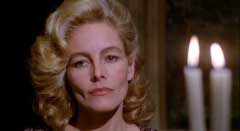
Patrizi’s acting career began with a supporting role alongside Burt Lancaster, Silvana Mangano and Helmut Berger in Luchino Visconti’s CONVERSATION PIECE, a set-bound chamber drama scripted as such because of the director’s failing health. He also appeared in Umberto Lenzi’s ROME ARMED TO THE TEETH and Romolo Guerrieri’s YOUNG, VIOLENT, AND DANGEROUS. Soon after MURDER OBSESSION, Patrizi stopped acting and moved behind the scenes as the head of an advertising company producing commercials. He’s pretty bland here, but the script requires him to be the only character who suspects nothing odd for a ridiculous amount of the film’s running time. Dionisio spends much of the running time running around and screaming – often with her clothes ripped away – but she’ll be enough of a fresh face to most Italian horror fans to hold interest. Dionisio was once married to director Ruggero Deodato, and had appeared in his films WAVE OF LUST and LIVE LIKE A COP, DIE LIKE A MAN (in which her sister Sofia – with whom she shared an Italian PLAYBOY pictorial – also appeared), although her career began with a small role in John Schlesinger’s DARLING (along side her LIVE LIKE A COP co-star Ray Lovelock). She also played one of the stalked schoolgirls of Mario Bava’s NAKED YOU DIE, the train-hopping prostitute of Ferdinando Baldi’s TERROR EXPRESS, and the youngest virginal daughter in ANDY WARHOL’S DRACULA, among others. MURDER OBSESSION was one of her last films as, according to Deodato, she decided to focus on being a mother (they have a son together, but I am not certain whether she remarried). Austrian model Strindberg is still as smokin’ here as she was in her debut: Fulci’s A LIZARD IN A WOMAN’S SKIN as the object of Florinda Bolkan’s obsession. Her Italian career include some memorable gialli such as Sergio Martino’s YOUR VICE IS A LOCKED ROOM AND ONLY I HAVE THE KEY and CASE OF THE SCORPION’S TAIL, Aldo Lado’s WHO SAW HER DIE, Duccio Tessari’s PUZZLE, Tullio Demichelli’s TWO FACES OF FEAR and Eduardo Mulgaria’s TROPIC OF CANCER. MURDER OBSESSION was her last film, and she is reportedly living comfortably in Los Angeles.
 Richardson
was one of Rank’s last contact players – along with his BLACK SUNDAY
co-star Barbara Steele – and appeared in the Hammer pics SHE, THE VENGEANCE
OF SHE and ONE MILLION YEARS B.C. (during this time he was married to Martine
Beswick). He was nearing the end of his Italian horror career which included
roles in Sergio Martino’s TORSO, Alfonso Brescia’s low-budget space
operas WAR OF THE PLANETS and BATTLE OF THE STARS, Umberto Lenzi’s EYEBALL,
Mario Mancini’s FRANKENSTEIN ‘80 and Ferdinando Baldi’s NINE
GUESTS FOR A CRIME with Sofia Dionisio. One of his last Italian horror appearances
was in Michele Soavi’s THE CHURCH. He eventually left acting and has become
a photojournalist. Gemser was of course familiar to Italian audiences as Joe
D’Amato’s “Black Emanuelle” and is called upon here
to doff her clothes (thrice) and get killed. The French co-production quota
brought with it actor Henri Garcin, who also appeared in Truffaut’s THE
WOMAN NEXT DOOR and Nicolas Gessner’s SOMEONE BEHIND THE DOOR with Charles
Bronson, and as Conrad Bain’s French equivalent in MAGUY, the long-running
French remake of the American sitcom MAUDE. Brochard’s presence may have
also fulfilled a quota requirement, but she was already familiar to Italian
genre cinema as the apparent heroine of Lenzi’s EYEBALL, Anais Nin to
David Brandon’s Henry Miller in Joe D’Amato’s New Orleans-set
HENRY & JUNE cash-in ROOM OF WORDS, as well as two well-received 1990s Tinto
Brass efforts: PAPRIKA and THE VOYEUR. The same year Brochard appeared in Freda’s
film, she also appeared in the Ernesto Gastaldi’s NOTTURNO CON GRIDA,
a sequel to his 1965 psychosexual thriller LIBIDO that also mixed the occult
with a murder mystery (and was possibly shot in some of the same wooded locations).
Richardson
was one of Rank’s last contact players – along with his BLACK SUNDAY
co-star Barbara Steele – and appeared in the Hammer pics SHE, THE VENGEANCE
OF SHE and ONE MILLION YEARS B.C. (during this time he was married to Martine
Beswick). He was nearing the end of his Italian horror career which included
roles in Sergio Martino’s TORSO, Alfonso Brescia’s low-budget space
operas WAR OF THE PLANETS and BATTLE OF THE STARS, Umberto Lenzi’s EYEBALL,
Mario Mancini’s FRANKENSTEIN ‘80 and Ferdinando Baldi’s NINE
GUESTS FOR A CRIME with Sofia Dionisio. One of his last Italian horror appearances
was in Michele Soavi’s THE CHURCH. He eventually left acting and has become
a photojournalist. Gemser was of course familiar to Italian audiences as Joe
D’Amato’s “Black Emanuelle” and is called upon here
to doff her clothes (thrice) and get killed. The French co-production quota
brought with it actor Henri Garcin, who also appeared in Truffaut’s THE
WOMAN NEXT DOOR and Nicolas Gessner’s SOMEONE BEHIND THE DOOR with Charles
Bronson, and as Conrad Bain’s French equivalent in MAGUY, the long-running
French remake of the American sitcom MAUDE. Brochard’s presence may have
also fulfilled a quota requirement, but she was already familiar to Italian
genre cinema as the apparent heroine of Lenzi’s EYEBALL, Anais Nin to
David Brandon’s Henry Miller in Joe D’Amato’s New Orleans-set
HENRY & JUNE cash-in ROOM OF WORDS, as well as two well-received 1990s Tinto
Brass efforts: PAPRIKA and THE VOYEUR. The same year Brochard appeared in Freda’s
film, she also appeared in the Ernesto Gastaldi’s NOTTURNO CON GRIDA,
a sequel to his 1965 psychosexual thriller LIBIDO that also mixed the occult
with a murder mystery (and was possibly shot in some of the same wooded locations).
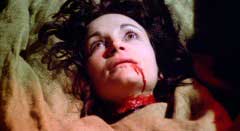
MURDER OBSESSION reached these shores through Charles Band’s Wizard Video in a big box with the replacement title FEAR (the Greek and Venezuelan videotapes bore the original English export title UNCONSCIOUS (an alternate Greek release featured a garish cover and the title SATAN’S ALTAR), while the UK and UK-sourced Canadian releases were retitled THE WAILING). The Italian arm of Raro Video released the film on disc in a non-anamorphic widescreen transfer of the longer Italian version with both Italian and English tracks (and English subtitles for the Italian-only scenes). English subtitles were offered for the supplementary interview with Sergio Stivaletti. The Italian version features extended a handful of extended scenes and one entirely cut sequence. First off, after the opening scene in the film studio, we see Michael at home playing the guitar and singing along (badly) for a few seconds before the English version resumes with Michael discovering the photograph of him as a child. While Michael and Deborah are driving, Michael’s flashback of his father conducting an orchestra is extended to reveal his father having a heart attack. The next extension occurs when Oliver shows Deborah to her room and informs her that the room next to hers is Michael’s father’s study. The fourth Italian-only bit is an entire deleted scene in which Glenda and Hans talk about Michael killing his father as a child (it kind of plays like a redundant deleted scene, but it does establish character relationships and the whereabouts of two people around the time of Beryl’s attack). The last extension occurs when Glenda and Deborah are having dinner, and Oliver tells them that the “mechanical saw” is missing and he does not know where Susan has gone. The English version also differs in moving the first half of Deborah’s nightmare to an earlier point so that it plays as real, rather than as a recounted flashback (the Wizard tape of the English version also loses a two minute portion of this sequence present in the other export editions, possibly to fit the film on a T-90 cassette).
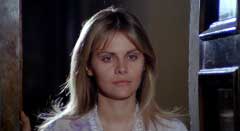 The
Italian track featured a piano-dominated classical score by Franco Mannino,
who had composed the classical orchestral scores for Luchino Visconti’s
last films CONVERSATION PIECE – also featuring Patrizi – and L’INNOCENTE
(he also conducted the classical source music utilized in Visconti’s LUDWIG
and DEATH IN VENICE). The score features some original compositions by Mannino,
but it also works in Bach’s “Well Tempered Clavier” and “Jesu,
Joy of Man’s Desiring” and Liszt’s “Liebestraum”
throughout (even the folksy guitar piece Patrizi is singing early on is to the
melody of the Liszt composition). Although Mannino is credited on the English
track, it is uncertain whether he composed the bombastic synthesizer score featured
in this version (it is certain possible, though, and may have been a product
of the classical composer experimenting with new technology). The English track
slathers music over several sequences that play with only dialogue and/or sound
effects on the Italian track as if the preparers of the English version were
afraid of silence, and Mannino’s original piano pieces are absent (the
classical source pieces remain throughout, however). The English dub track features
some very familiar players. Silvia Dionisio was voiced by Pat Starke, who dubbed
a lot of screamers such as Lorraine de Selle in HOUSE BY THE EDGE OF THE PARK
and CANNIBAL FEROX, Daniela Doria’s razored prostitute in NEW YORK RIPPER,
Antonella Interlenghi’s Emily in CITY OF THE LIVING DEAD, and the nosy
reporter of Juan Picquer Simon’s PIECES among others. Laura Gemser was
dubbed by Susan Spafford, who also dubbed Olga Karlatos in Lucio Fulci’s
ZOMBIE, as well as the axed mother in the opening of PIECES. Carolyn De Fonseca
dubbed Anita Strindberg, and her cries of “damn you, damn you” will
evoke memories of her dubbing of Mariangela Giordano in Andrea Bianchi’s
BURIAL GROUND from the same year (while Starke and Spafford dubbed the other
two lead women). De Fonseca’s voice may also be familiar as the dubber
of Daria Nicolodi in Argento’s DEEP RED, and Barbara Magnolfi’s
bitchy ballerina in SUSPIRIA. Frank von Kuegelgen dubbed Stefano Patrizi, and
his voice may be familiar to viewers as the dubbing voice of Paolo Malco in
HOUSE BY THE CEMETERY or Carlo de Mejo in CITY OF THE LIVING DEAD.
The
Italian track featured a piano-dominated classical score by Franco Mannino,
who had composed the classical orchestral scores for Luchino Visconti’s
last films CONVERSATION PIECE – also featuring Patrizi – and L’INNOCENTE
(he also conducted the classical source music utilized in Visconti’s LUDWIG
and DEATH IN VENICE). The score features some original compositions by Mannino,
but it also works in Bach’s “Well Tempered Clavier” and “Jesu,
Joy of Man’s Desiring” and Liszt’s “Liebestraum”
throughout (even the folksy guitar piece Patrizi is singing early on is to the
melody of the Liszt composition). Although Mannino is credited on the English
track, it is uncertain whether he composed the bombastic synthesizer score featured
in this version (it is certain possible, though, and may have been a product
of the classical composer experimenting with new technology). The English track
slathers music over several sequences that play with only dialogue and/or sound
effects on the Italian track as if the preparers of the English version were
afraid of silence, and Mannino’s original piano pieces are absent (the
classical source pieces remain throughout, however). The English dub track features
some very familiar players. Silvia Dionisio was voiced by Pat Starke, who dubbed
a lot of screamers such as Lorraine de Selle in HOUSE BY THE EDGE OF THE PARK
and CANNIBAL FEROX, Daniela Doria’s razored prostitute in NEW YORK RIPPER,
Antonella Interlenghi’s Emily in CITY OF THE LIVING DEAD, and the nosy
reporter of Juan Picquer Simon’s PIECES among others. Laura Gemser was
dubbed by Susan Spafford, who also dubbed Olga Karlatos in Lucio Fulci’s
ZOMBIE, as well as the axed mother in the opening of PIECES. Carolyn De Fonseca
dubbed Anita Strindberg, and her cries of “damn you, damn you” will
evoke memories of her dubbing of Mariangela Giordano in Andrea Bianchi’s
BURIAL GROUND from the same year (while Starke and Spafford dubbed the other
two lead women). De Fonseca’s voice may also be familiar as the dubber
of Daria Nicolodi in Argento’s DEEP RED, and Barbara Magnolfi’s
bitchy ballerina in SUSPIRIA. Frank von Kuegelgen dubbed Stefano Patrizi, and
his voice may be familiar to viewers as the dubbing voice of Paolo Malco in
HOUSE BY THE CEMETERY or Carlo de Mejo in CITY OF THE LIVING DEAD.
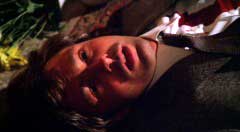 Raro
Video’s anamorphic 1.85:1 single-layer transfer is certainly an improvement
over the Italian edition – in terms of framing, contrast, color and detail
(the blown-out whites on the Italian disc are not unlike their transfer of the
Italian cut of BAY OF BLOOD) – but not exactly definitive. Just as the
Raro import prefaces its presentation by saying they have chosen to use the
longer Italian version, Raro USA tells us they have decided to add scenes from
the Italian version to the English version; however, it is technically the Italian
version in content and in its opening and closing credits sequences (the export
prints of course featured English credits as well as an onscreen translation
of the opening epigraph) rather than a composite of the English version with
scenes from the Italian. The Stivaletti interview (10:03) is carried over here.
MURDER OBSESSION was one of Stivaletti’s earliest effects projects (for
which he is uncredited). Stivaletti was introduced to the film’s effects
supervisor Angelo Mattei – who did the rotting corpses on Dario Argento’s
INFERNO – by Lamberto Bava, for whom Stivaletti would work on DEMONS and
DEMONS 2 (following his effects on Argento’s PHENOMENA on which Bava Jr.
was assistant director). He recalls working on the effects, including versions
of the effects that didn’t work, and concluding that working with the
cinema great Freda was not an edifying experience. As with BODY PUZZLE, Raro
has been a bit careless with the package. The back cover erroneously lists the
audio as being Italian with English subtitles, and boasts of non-existent “New
and improved English subtitles” (other than the translation of the opening
epigraph, the subtitles for the Italian-only appear to be same as on the import).
The special features list on the back cover also list “Cut scene footage”
but that snippet on the import edition is not included. It also describes the
film as one of Freda’s “sexiest giallos” (the plural is gialli,
but I mean the adjective). (Eric
Cotenas)
Raro
Video’s anamorphic 1.85:1 single-layer transfer is certainly an improvement
over the Italian edition – in terms of framing, contrast, color and detail
(the blown-out whites on the Italian disc are not unlike their transfer of the
Italian cut of BAY OF BLOOD) – but not exactly definitive. Just as the
Raro import prefaces its presentation by saying they have chosen to use the
longer Italian version, Raro USA tells us they have decided to add scenes from
the Italian version to the English version; however, it is technically the Italian
version in content and in its opening and closing credits sequences (the export
prints of course featured English credits as well as an onscreen translation
of the opening epigraph) rather than a composite of the English version with
scenes from the Italian. The Stivaletti interview (10:03) is carried over here.
MURDER OBSESSION was one of Stivaletti’s earliest effects projects (for
which he is uncredited). Stivaletti was introduced to the film’s effects
supervisor Angelo Mattei – who did the rotting corpses on Dario Argento’s
INFERNO – by Lamberto Bava, for whom Stivaletti would work on DEMONS and
DEMONS 2 (following his effects on Argento’s PHENOMENA on which Bava Jr.
was assistant director). He recalls working on the effects, including versions
of the effects that didn’t work, and concluding that working with the
cinema great Freda was not an edifying experience. As with BODY PUZZLE, Raro
has been a bit careless with the package. The back cover erroneously lists the
audio as being Italian with English subtitles, and boasts of non-existent “New
and improved English subtitles” (other than the translation of the opening
epigraph, the subtitles for the Italian-only appear to be same as on the import).
The special features list on the back cover also list “Cut scene footage”
but that snippet on the import edition is not included. It also describes the
film as one of Freda’s “sexiest giallos” (the plural is gialli,
but I mean the adjective). (Eric
Cotenas)